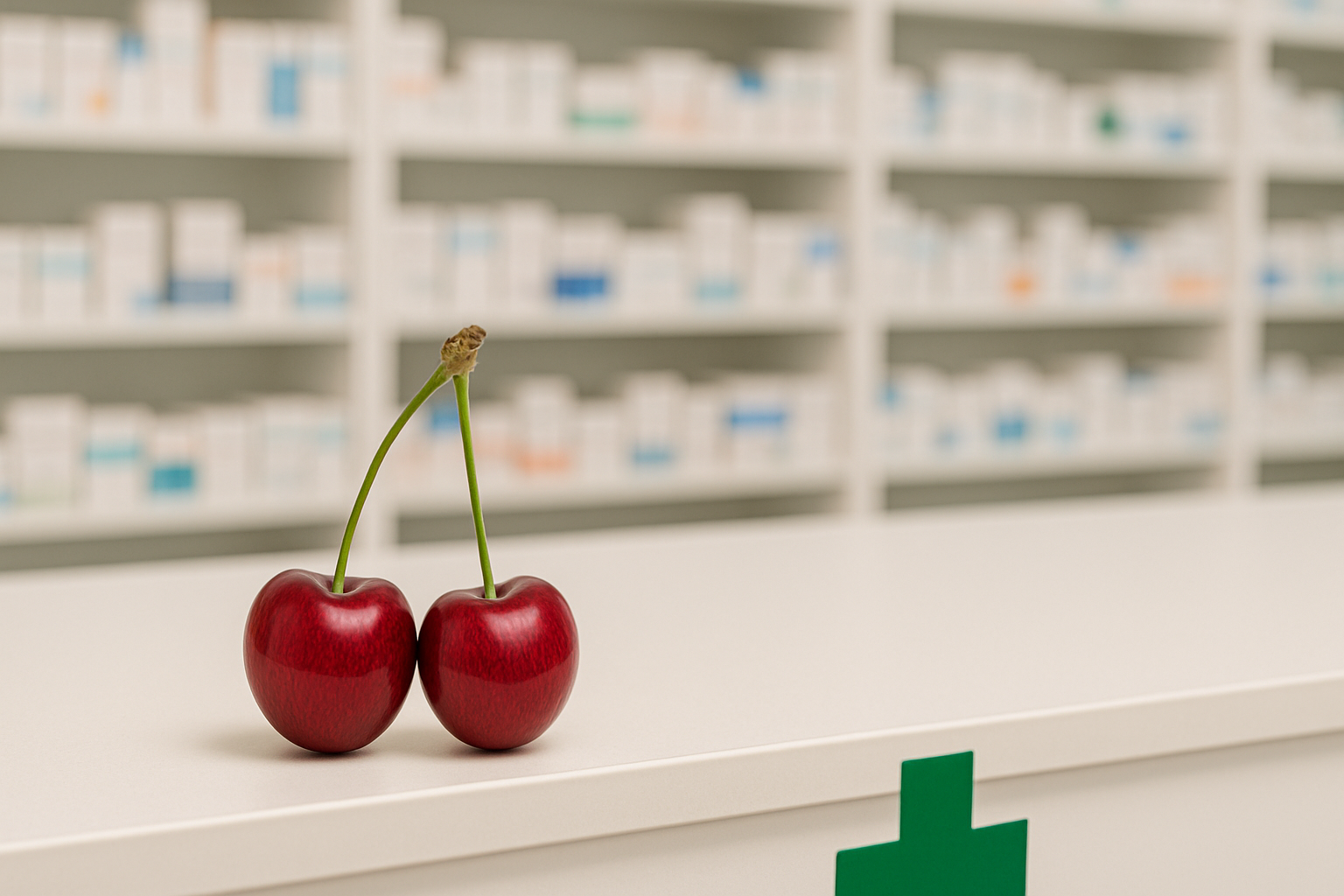**ENG**
Good morning everyone, today I would like to bring to your attention another article from “ under the peel”, the column in which we learn together the nutritional properties of the most consumed fruit in the world. If you are interested in these topics, don’t forget to follow my profile. That said… let’s go!

image created with openai.com
Cherry is one of the most loved fruits of spring and early summer. With its sweet taste, sometimes slightly acidic, is the protagonist of sweets, jams and healthy snacks. But in addition to being delicious, cherry is a real treasure chest beneficial property for health. Let's find out together what makes this small fruit so special, and some curiosities that you perhaps did not know.
A concentrate of nutrients
Although small, cherry is surprisingly rich in vitamins, mineral salts and antioxidants.
Cherries are an excellent source of natural melatonin, the hormone that regulates the sleep-wake rhythm. Recent studies suggest that consuming cherries, in particular those of the Montmorency variety (more acidule), can help improve sleep quality and reduce insomnia disorders.
Thanks to their composition, cherries can have numerous positive effects on the body:
Anti -inflammatory and pain -relieving: flavonoids contained in cherries help to reduce joint and muscle pain, even in the case of pathologies such as arthritis.
Cardioprotective: Anthocyanins and potassium favor heart health, reducing blood pressure and improving blood cholesterol levels.
Purifying and diuretic: they help the kidneys to eliminate toxins, reducing water retention.
Allied against aging: antioxidants contrast free radicals, slowing down the signs of skin and cellular aging.
Finally, there is no lack of studies that associate regular consumption of cherries with a better physical recovery after sporting activities and greater protection of the brain from cognitive aging.
Curiosity and culture of cherry
An ancient story
Cherries are originally from Asia Minor, and it is said that they were brought to Europe by the Romans in the first century BC. Lucullo, a famous Roman general, would have discovered them during the military campaigns in Türkiye and would have introduced them to Italy. From here they spread throughout the continent.
Their scientific name, Prunus Avium, literally means "bird's pruno", because these fruits are also particularly loved by animals.
Cherry and popular traditions
A popular saying reads: "One pulls the other". Not surprisingly: the irresistible flavor and the small size make cherries one of the most "dangerous" snacks for the line! Fortunately, consumed in moderation, they are a healthy and natural alternative to snacks.
In Italy, there are several festivals dedicated to this fruit: among the best known, those of Vignola (MO) and Lari (PI), where the most valuable local varieties are celebrated with events, markets and tastings.
Varieties and colors
There are over 1,000 varieties of cherries in the world, but the most common are divided into two large groups:
Sweets (Prunus Avium): Like the duronies and more, larger and more fleshy.
Acid (Prunus Cerasus): like black cherries and mistials, mainly used for jams and liqueurs (think of the famous maraschino or the cortex tart).
The colors range from light red to intense black, passing through varieties with a yellow-red color, less common but very sweet.
How to keep them and enjoy them
Cherries are delicate fruits: they are preserved in the refrigerator for a maximum of 3-4 days, and should be washed only at the time of consumption to prevent them from deteriorating more quickly.
They can be enjoyed fresh, or in a thousand preparations:
Tarts and spoon desserts
Jams and jams
Liqueurs and syrups
In combination with yogurt, ice cream or cereals
For those who want to stock up, cherries lend themselves very well to the freezing: just pity them and keep them in hermetic bags.
Conclusion
Sweets, colorful, healthy: cherries are the perfect symbol of spring that turns into summer. Not only do they satisfy the palate, but offer a multitude of health benefits. One more reason to take advantage of it when the season is right ... without exaggerating, because - as the grandparents said - "Eating too many cherries can give stomach ache"!
**ITA**
Buongiorno a tutti, oggi vorrei portare alla vostra attenzione un altro articolo di “sotto la buccia”, la rubrica in cui impariamo assieme le proprietà nutrizionali della frutta più consumata nel mondo. Se ti interessano queste tematiche non dimenticarti di seguire il mio profilo. Detto questo … partiamo!

image created with openai.com
La ciliegia è uno dei frutti più amati della primavera e dell’inizio dell’estate. Con il suo sapore dolce, a volte lievemente acidulo, è protagonista di dolci, confetture e spuntini sani. Ma oltre ad essere deliziosa, la ciliegia è un vero e proprio scrigno di proprietà benefiche per la salute. Scopriamo insieme cosa rende questo piccolo frutto così speciale, e qualche curiosità che forse non conoscevi.
Un concentrato di nutrienti
Anche se piccola, la ciliegia è sorprendentemente ricca di vitamine, sali minerali e antiossidanti.
Le ciliegie sono un'ottima fonte di melatonina naturale, l’ormone che regola il ritmo sonno-veglia. Studi recenti suggeriscono che consumare ciliegie, in particolare quelle della varietà Montmorency (più acidule), può aiutare a migliorare la qualità del sonno e ridurre i disturbi dell’insonnia.
Grazie alla loro composizione, le ciliegie possono avere numerosi effetti positivi sull'organismo:
Antinfiammatorie e antidolorifiche: i flavonoidi contenuti nelle ciliegie aiutano a ridurre dolori articolari e muscolari, anche in caso di patologie come l’artrite.
Cardioprotettive: gli antociani e il potassio favoriscono la salute del cuore, riducendo la pressione arteriosa e migliorando i livelli di colesterolo nel sangue.
Depurative e diuretiche: aiutano i reni a eliminare le tossine, riducendo la ritenzione idrica.
Alleate contro l’invecchiamento: gli antiossidanti contrastano i radicali liberi, rallentando i segni dell’invecchiamento cutaneo e cellulare.
Non mancano infine studi che associano il consumo regolare di ciliegie a un miglior recupero fisico dopo l’attività sportiva e a una maggiore protezione del cervello dall’invecchiamento cognitivo.
Curiosità e cultura della ciliegia
Una storia antichissima
Le ciliegie sono originarie dell’Asia Minore, e si racconta che furono portate in Europa dai Romani nel I secolo a.C. Lucullo, famoso generale romano, le avrebbe scoperte durante le campagne militari in Turchia e le avrebbe introdotte in Italia. Da qui si diffusero in tutto il continente.
Il loro nome scientifico, Prunus avium, significa letteralmente “pruno degli uccelli”, perché questi frutti sono particolarmente amati anche dagli animali.
Ciliegie e tradizioni popolari
Un detto popolare recita: “Una tira l’altra”. Non a caso: il sapore irresistibile e la dimensione ridotta rendono le ciliegie uno degli snack più “pericolosi” per la linea! Per fortuna, consumate con moderazione, sono un’alternativa sana e naturale alle merendine.
In Italia, esistono diverse sagre dedicate a questo frutto: tra le più note, quelle di Vignola (MO) e Lari (PI), dove si celebrano le varietà locali più pregiate con eventi, mercatini e degustazioni.
Varietà e colori
Esistono oltre 1.000 varietà di ciliegie nel mondo, ma le più diffuse si dividono in due grandi gruppi:
Dolci (Prunus avium): come le duroni e le morette, più grandi e carnose.
Acide (Prunus cerasus): come le amarene e le visciole, usate soprattutto per marmellate e liquori (pensa al celebre maraschino o alla crostata di amarene).
I colori vanno dal rosso chiaro al nero intenso, passando per varietà dal colore giallo-rosato, meno comuni ma molto dolci.
Come conservarle e gustarle
Le ciliegie sono frutti delicati: si conservano in frigorifero per massimo 3-4 giorni, e andrebbero lavate solo al momento del consumo per evitare che si deteriorino più rapidamente.
Possono essere gustate fresche, oppure in mille preparazioni:
Crostate e dolci al cucchiaio
Confetture e marmellate
Liquori e sciroppi
In abbinamento a yogurt, gelato o cereali
Per chi vuole fare scorta, le ciliegie si prestano benissimo alla congelazione: basta snocciolarle e conservarle in sacchetti ermetici.
Conclusione
Dolci, colorate, sane: le ciliegie sono il simbolo perfetto della primavera che si trasforma in estate. Non solo soddisfano il palato, ma offrono una moltitudine di benefici per la salute. Un motivo in più per approfittarne quando la stagione è giusta… senza esagerare, perché – come dicevano i nonni – “mangiare troppe ciliegie può dare mal di pancia”!
Sources - Fonti :
https://www.humanitas.it/enciclopedia/alimenti/frutta/ciliegie/
https://www.cure-naturali.it/enciclopedia-naturale/alimentazione/nutrizione/ciliegie.html
Cherries - under the peel
@ghilvar
· 2025-07-18 15:01
· Olio di Balena
#ita
#eng
#oliodibalena
#cherry
#nature
#health
Payout: 0.000 HBD
Votes: 85
More interactions (upvote, reblog, reply) coming soon.